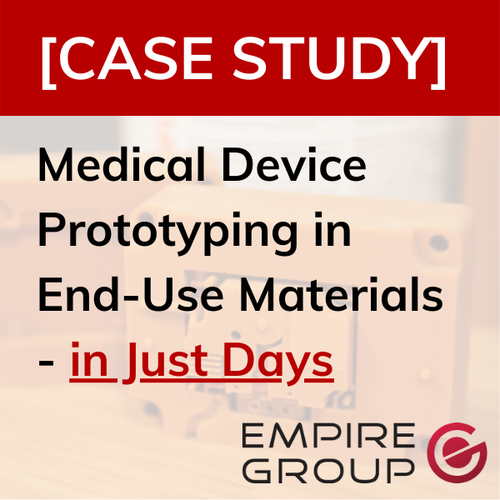3D Printing vs. Rapid Injection Molding For Prototyping & Beyond
This article explains the pros and cons of 3D printing and rapid injection molding, with a focus on how novel capabilities have opened up new possibilities for manufacturers.
As we explore below, rapid injection molding is emerging as a valuable option for not only prototyping, but cost-effective, agile, smaller production runs.
When Should I Use Rapid Injection Molding v. 3D Printing?
More and more product development teams are taking advantage of 3D printed prototypes, which can be fabricated more quickly than injection molded parts made using aluminum injection molding tools (often called “quick turn tooling” or “soft tooling”). 3D printed parts only require a lead time of 1-3 days, while traditional soft tooling can require anywhere from 2 weeks to 2 months, depending on the complexity of the part.
A faster turnaround time for prototypes allows designers to iterate more quickly and catch potential issues earlier in the development cycle. Quick turn tooling can take anywhere from a few weeks to several months to return a workable prototype. This waiting time introduces delays to the product development process and forces a design to be locked in place while waiting for a prototype. If the prototype suggests that design changes will be required, another cycle of delays is imposed.
In this context, 3D printed prototypes offer some clear strategic advantages over traditional rapid injection molding. Faster prototyping times can cut the product development cycle in half, allowing for more iteration, more design refinement, and ultimately a faster time to market.
3D printed parts, however, exhibit important limitations. They cannot accommodate a broad range of engineering-grade materials. For many designs, 3D printed parts simply do not have the capability to replicate the mechanical characteristics of final production materials. For highly engineered and/or regulated products, like those in the automotive or medical device industries, 3D printed components lack the chemical and mechanical properties needed to support requisite testing. Even for parts made from materials which can be 3D printed, like nylon, mechanical properties tend to diverge from their injection molded equivalents.
Empire Group’s process leverages a proprietary composite for its 3D printed injection molds. This material exhibits the durability and temperature resistance needed to mold parts out of production-grade materials like nylon or ULTEM, while allowing for surface finishes and tolerances that meet most product requirements. This novel approach to rapid injection molding is cost competitive with aluminum quick turn tooling while offering a much faster turnaround time. And parts can be made from a much greater variety of materials than if they are 3D printed directly.
3D printed molds do exhibit some limitations compared to aluminum molds. Tight draft angles and fine feature sizes (below 5 microns) can be challenging and may require small accommodations in the design to maximize the lifespan of the mold.
Rapid Injection Molding Beyond Prototyping
As production volume increases, 3D printing an injection mold quickly becomes more economical than 3D printing components directly. While the precise volume where it becomes more efficient to use an injection mold varies depending on part geometry, around two dozen parts is a reliable rule of thumb. Past this point, 3D printed molds can support cost-competitive production up to around 5000 units.
At these volumes, rapid injection molding can offer outstanding value in a number of use cases beyond prototyping. By using rapid injection for an initial marketing test run, a product can be tested with end users before the design is locked in by investment in an expensive bulk injection mold. Or, for manufacturers of limited volume products like after-market parts, rapid injection molding can provide cost-competitive manufacturing for entire small production runs. 3D printed molds can be easily stored for later use if more parts are required. Even for products that may eventually require higher volume production techniques, 3D printed molds can be the perfect fit for “bridge tooling” production between prototyping and finalization of a design for high-volume production.
Learn More About Rapid Manufacturing with Empire Group
Empire Group provides high-touch, end-to-end product development support. Empire Group’s expertise in prototyping, product development and rapid manufacturing allows us to offer clients a one-stop shop designed to provide rapid manufacturing as a true turnkey solution. We work closely with clients to identify the right manufacturing approach and shepherd products from design, to prototype, to production - all under the same roof.
If you’re interested in discussing how we can help with your product, contact us to start a conversation.






